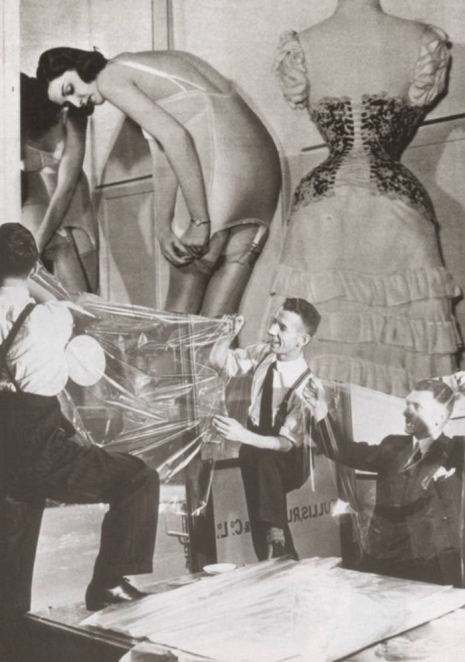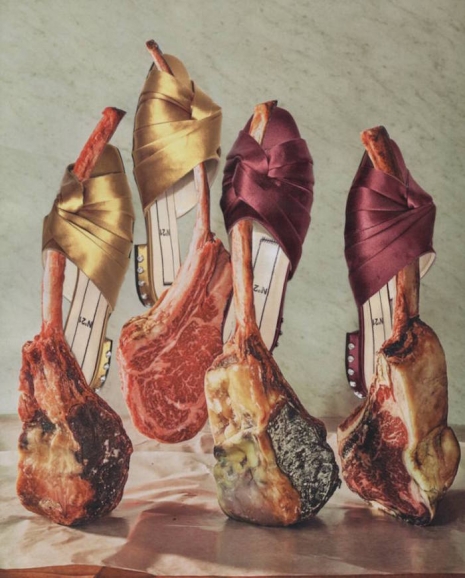
‘Cross Pollination.’
I could probably spend days looking at artist Deborah Stevenson‘s collage artworks. Well, maybe a slight exaggeration but let’s say hours or at least some considerable time, definitely, as each of Stevenson’s brilliant, complex pictures sets in motion a series of associations and ideas—whether intended or accidental—that connect towards a unifying narrative.
Take for example Cross Pollination which instantly startles with its reworking of Ingres’ portrait of Mademoiselle Caroline Rivière with Harold Edgerton’s photograph Bullet Through Apple.
Okay, so let’s go for basics. My first (obvious) thought was Adam and Eve and the eating of the apple and the start of institutionalized misogyny. Then I noticed the clothes worn by Rivière. Adam and Eve had supposedly been naked in the Garden of Eden. Being naked often signified the status of being a slave in ancient times. While being clothed is about power, freedom, and performance. Ingres’ portrait shows the teenage Rivière (she was about fourteen at the time) as a “ravishing beauty”—even Ingres’ words have multiple connotations—dressed in her finest clothes. She is presented as pure and virginal with the loop of a boa encircling her arms and body like a snake from the Garden of Eden.
Ingres has idealized this portrait and sexualized Rivière. The painting was not well-received when first exhibited as it was considered too Gothic and shockingly eroticised. Mademoiselle Rivière died within a year of the painting’s completion.
Then there is the violence of the exploding apple which is used to replace Rivière’s head. This could suggest the whole history of violence against women or the frustration of being a woman in such oppressive times. What it may also suggest is that in this collage, this photographic image captures one fleeting moment in time. Edgerton invented the electronic flash which enabled him to take his incredible photograph of a bullet passing through an apple. This image, this portrait, is similarly only one fleeting glimpse, one two dimensional aspect of something far more incredibly complex and subtle of which we only have but a small understanding.
Then there are the conversation pieces about identity, the male gaze, religion, and science, and the female body. And so it goes on… Of course, whether Stevenson’s intends all of this micro-reading I dunno, but you get the idea. You can, or at least I can riff on Stevenson’s work for hours. Whether that’s of any value to you, is for you to decide. What I do know is this is one of the things that makes Stevenson’s collage work so rich, so important, so beautiful, and so utterly compelling.
American artist Deborah Stevenson first came to prominence as a painter. Her work includes a series of Brooklyn skylines and another on structures and buildings. These works are beautiful, iconic and idiosyncratic. They mark the talents of an artist who can surprise the viewer by making them aware of the strangeness and beauty in the most unexpected of places.
About seven years ago, Stevenson started making collages. As a painter, she found the process of making collages accessed a different part of her consciousness. This was no longer representational work of urban landscapes but something that worked intuitively as she explained to Klassic Magaizne:
I don’t set out to do a specific image. My work table is crowded with stacks of images I have cut from a variety of print sources (I only use original material, never printing out or doing digital) and I shift them around until something strikes me. I may pick out one image as particularly striking, and then continue moving the images around until I see something that seems to ‘fit’ with the first one. It is an adventure with my muse, and most important to the process is my ability to pay attention and listen to the whispers the muse makes to me, then I see the piece. There are recurring themes in my work: the Feminine, current events, moods and internal states of being, and fashion mash ups. Finding pieces to put together is the easy part: it is the cutting and pasting that can be very labor-intensive and delicate.
Stevenson’s collages aren’t decorative work but intended to express “ideas that would be difficult to put into words, but come out very easily and clearly in imagery.” Her work is an “exploration of concepts of power, beauty, the Feminine, and mysterious archetypal conjunctions.”
The work arises in an ‘automatic’ way; I do not set out with an objective or goal in my mind when I sit down to make something. The images compose themselves spontaneously as I mix and move the masses of paper around on the table in front of me. I feel as though my eyes and hands facilitate the ‘arrival’ of the pictures that I make.
See more of Deborah Stevenson’s work here and here.

‘Cover Up.’

‘Show Horns.’
See more of Deborah Stevenson’s collages, after the jump…





